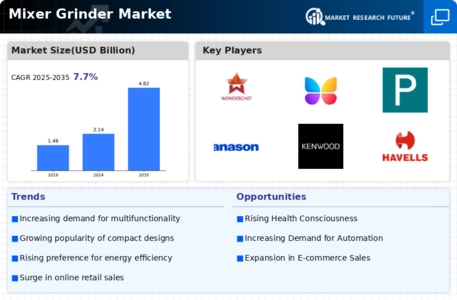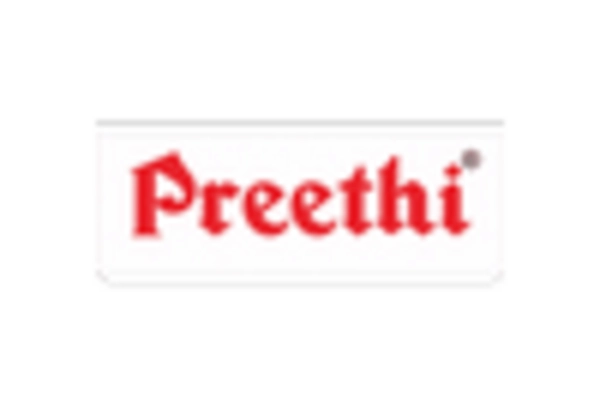Increasing Urbanization
The trend of increasing urbanization appears to be a significant driver for the Mixer Grinder Market. As more individuals migrate to urban areas, the demand for compact and efficient kitchen appliances rises. Urban dwellers often seek appliances that save space while providing multifunctional capabilities. This shift is reflected in the growing number of households that prioritize convenience and efficiency in their cooking processes. According to recent data, urban households are more likely to invest in modern kitchen appliances, including mixer grinders, which are perceived as essential tools for quick meal preparation. The Mixer Grinder Market is likely to benefit from this demographic shift, as urban consumers tend to favor products that enhance their culinary experiences without occupying excessive kitchen space.
Rising Disposable Incomes
Rising disposable incomes across various regions are likely to bolster the Mixer Grinder Market. As consumers experience an increase in their financial capabilities, they tend to invest more in household appliances that enhance their cooking experiences. This trend is particularly evident in emerging economies, where a growing middle class is increasingly inclined to purchase modern kitchen appliances. Data suggests that households with higher disposable incomes are more likely to prioritize quality and functionality in their kitchen tools, including mixer grinders. Consequently, the Mixer Grinder Market may witness a surge in demand as consumers seek products that offer durability and advanced features, aligning with their evolving culinary needs.
Technological Advancements
Technological advancements in appliance design and functionality are driving innovation within the Mixer Grinder Market. Manufacturers are increasingly integrating smart technology into their products, allowing for enhanced user experiences. Features such as programmable settings, energy efficiency, and improved motor performance are becoming standard in modern mixer grinders. This evolution not only caters to consumer preferences for convenience but also aligns with the growing emphasis on energy-efficient appliances. Market data indicates that consumers are more inclined to purchase mixer grinders equipped with the latest technology, as these products often promise better performance and longevity. As a result, the Mixer Grinder Market is likely to see continued growth fueled by these technological innovations.
Growing E-commerce Platforms
The expansion of e-commerce platforms is transforming the way consumers purchase kitchen appliances, including those in the Mixer Grinder Market. With the convenience of online shopping, consumers can easily compare products, read reviews, and access a wider range of options than ever before. This trend is particularly appealing to tech-savvy consumers who prefer the ease of purchasing appliances from the comfort of their homes. Data indicates that online sales of kitchen appliances have surged, with mixer grinders being among the top-selling items. As e-commerce continues to grow, the Mixer Grinder Market is likely to benefit from increased visibility and accessibility, allowing manufacturers to reach a broader audience and drive sales.
Health-Conscious Consumer Behavior
The rising trend of health-conscious consumer behavior is significantly influencing the Mixer Grinder Market. As individuals become more aware of the importance of nutrition, there is an increasing demand for appliances that facilitate healthy cooking. Mixer grinders are often utilized for preparing smoothies, nut butters, and other health-oriented recipes, making them essential tools in health-focused kitchens. Market Research Future indicates that consumers are actively seeking appliances that support their dietary preferences, such as plant-based diets and organic food preparation. This shift in consumer behavior is likely to drive sales in the Mixer Grinder Market, as manufacturers respond by offering products that cater to these health-conscious trends.


















Leave a Comment